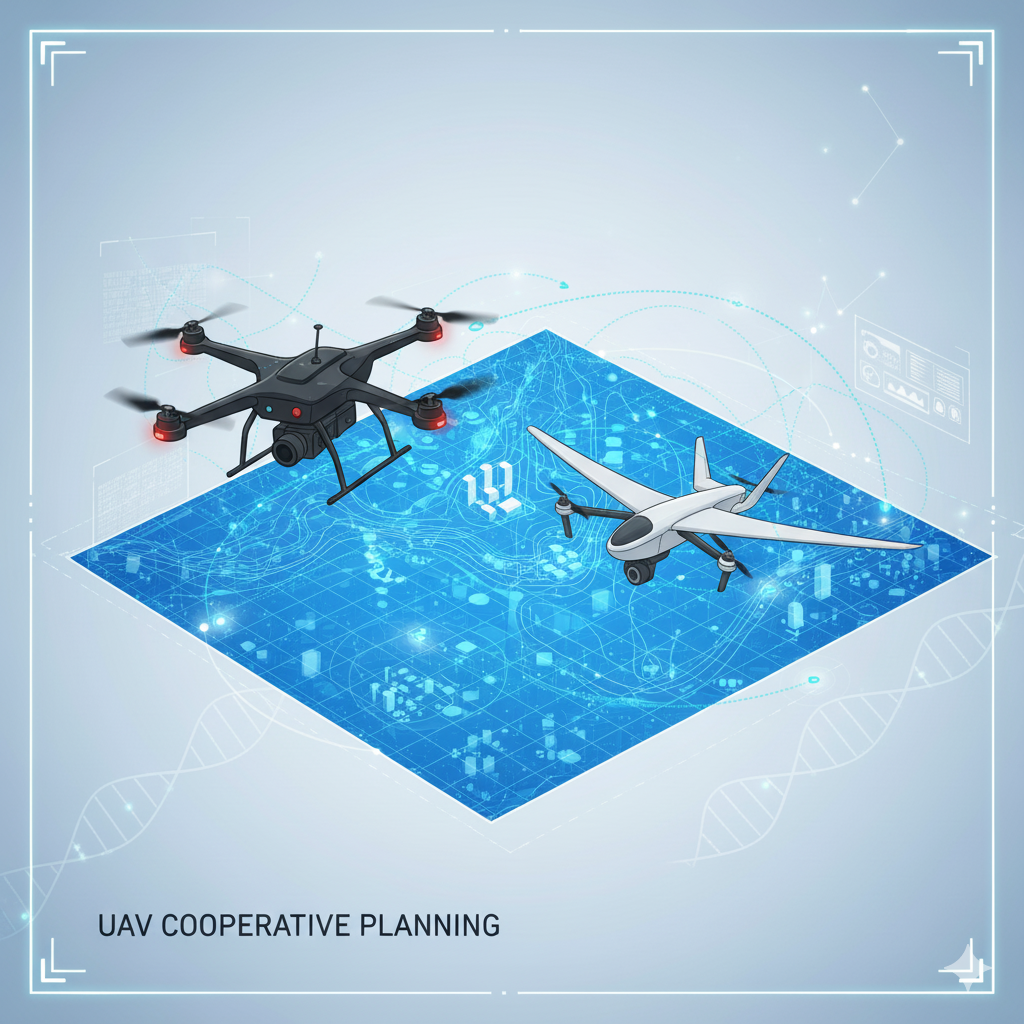Coordinated UAVs follow fixed paths. Cooperative UAVs think and adapt negotiating tasks, sharing awareness, and reallocating roles as conditions change.
As missions grow complex and communication becomes uncertain, planning systems must evolve from rigid scripts to resilient, self-correcting collaboration, enabling real-time drone swarm defense optimization.
With the UAV market expected to triple by 2032 and defense use rapidly expanding, the real test isn’t execution, it's sustaining cooperation when networks fail and priorities shift mid-flight.
Explore BQP’s UAV cooperative planning platform—Book a demo
The Evolution of Cooperative Planning in UAV Systems
Early UAV systems handled coordination, not cooperation assigning waypoints, keeping formation, and avoiding collisions.
Modern systems go further. UAVs now act as autonomous agents that share awareness, negotiate resources, and replan in real time as conditions change.
This evolution mirrors advances in distributed computing and multi-agent learning, but aerospace adds tougher constraints: strict physics, limited energy, and split-second decisions where a 100-millisecond delay can derail a mission.
The shift from formation flight to adaptive task swarms represents more than a technical upgrade, illustrating path planning in drone swarm operations.
Key Components of Cooperative Planning Architectures
Effective cooperative UAV planning relies on robust communication, adaptive control strategies, and reliable coordination mechanisms. These components ensure UAV teams can share situational awareness, allocate tasks dynamically, and maintain stable operations even under bandwidth constraints, network disruptions, or changing mission priorities.
Communication Networks – The Nervous System
Every UAV in the fleet needs situational awareness to act cohesively. Ultra-wideband (UWB) ensures precise positioning even when GPS signals fail. Lightweight cyber-twin models mirror each UAV’s state digitally, keeping coordination smooth even under limited connectivity or bandwidth constraints.
Adaptive Control – The Decision Engine
Control isn’t one-size-fits-all. Centralized planning optimizes overall mission objectives, while distributed control allows individual UAVs to make smart local decisions when conditions change. Hybrid strategies dynamically blend both approaches, ensuring resilience across varying network states and mission phases.
Coordination Mechanisms – The Task Orchestra
Task allocation turns planning into action. Fleets leverage hybrid strategies, like ant colony optimization, to share tasks efficiently across heterogeneous UAVs. The system remains stable even when timing assumptions fail, communication links break, or environmental constraints suddenly change.
Together, these layers transform a group of UAVs from isolated agents into a self-aware, adaptive, and resilient cooperative fleet, capable of handling complex, real-world missions with agility.
Algorithmic Foundations for Multi-UAV Collaboration
Modern cooperative UAV systems rely on three core algorithmic pillars that balance precision, adaptability, and real-time decision-making.
1. Graph-Based and Optimization Models
- Graphs define relationships between UAVs, routes, and constraints in shared airspace.
- Trajectory planning applies constrained optimization to minimize total mission cost while maintaining spatial separation and temporal alignment, a critical aspect of complex path planning in drone swarm operations.
- Spatial separation and temporal alignment
- Energy balance and maneuver feasibility
- Dubin's path optimization ensures compliance with UAV turn radius and velocity limits.
- Integer programming offers optimality but struggles with scalability; relaxations and approximations trade accuracy for computation speed.
- Core challenge: achieving feasible solutions within real-time constraints of dynamic missions.
2. Market-Based and Auction Algorithms
- Treat task allocation as an economic system—UAVs act as bidders valuing tasks based on distance, priority, or remaining energy.
- Enable dynamic reallocation as mission objectives shift.
- Key risks include:
- Greedy bidding leading to oscillations
- Communication latency producing outdated bids
- Complex valuation design balancing task value and resource use
- Market-based strategies are lightweight, flexible, and naturally suited for heterogeneous UAV teams.
3. Machine Learning for Adaptive Cooperation
- Reinforcement learning (RL) allows UAVs to learn cooperative behavior from experience rather than rely on pre-set rules.
- Multi-agent RL enables adaptive strategies that outperform manually designed policies.
- Practical challenges:
- Large data and training time requirements
- Policy opacity (limited interpretability)
- Sensitivity to unseen conditions during deployment
- Hybrid approaches blend genetic algorithms (GAs), surrogate optimization, and analytical propagators for near real-time replanning.
Managing Dynamic Environments and Real-Time Replanning
Real-time UAV cooperation requires both reactive and anticipatory planning. Event-driven replanning handles faults and emerging conditions, while predictive models and QA-PINNs forecast system states, enabling proactive, constraint-aware task allocation.
Event-Driven Reallocation Techniques
Real-time cooperative planning links task assignment and path planning in a closed loop. Event-driven architectures trigger replanning when a UAV reports a fault, a sensor detects a new target, or environmental conditions exceed thresholds.
This approach is efficient, replanning occurs only when needed but reactive, relying on timely event detection and propagation. Hierarchical replanning balances speed and scope: slow, global updates for mission objectives every few minutes, and fast, local adjustments several times per second.
Predictive Modeling for Anticipatory Coordination
Advanced systems anticipate events rather than merely reacting. Predictive models forecast battery depletion, sensor degradation, and target movement, enabling proactive reallocation. Physics-informed neural networks (PINNs) embed governing physical laws into learned models for accurate, generalized predictions.
Quantum-assisted PINNs (QA-PINNs) accelerate training and improve performance in sparse-data scenarios, ensuring anticipatory planning accounts for rare failure modes. The goal is actionable foresight good enough to outperform purely reactive approaches.
Practical Considerations for Deploying Cooperative UAV Fleets
Effective UAV cooperation requires planning that considers energy, collision avoidance, and scalability to ensure fleet performance and safety. Key considerations include:
- Energy and Endurance Constraints
- Battery limits impact all aspects of mission planning.
- Energy consumption varies with speed, payload, environment, and maneuvers.
- Frequent communication or rapid repositioning can deplete batteries faster than expected.
- As energy drops, UAV capabilities degrade: slower flight, reduced sensor range, and limited maneuverability.
- Treat energy as a dynamic state rather than a fixed constraint to avoid underperforming plans.
- Collision Avoidance and Airspace Integration
- Collision avoidance must be embedded in planning from the start.
- Minimum separation constraints add complexity, particularly for large swarms.
- Integrating UAVs into shared airspace requires predictable behavior for manned aircraft and other autonomous systems.
- Top-performing cooperative algorithms may require compromises to meet regulatory standards.
- Scalability Challenges with Increasing Fleet Size
- Every planning algorithm has practical fleet-size limits.
- Centralized planning can become a bottleneck when gathering state data and computing plans.
- Hierarchical architectures divide fleets into sub-swarms coordinated by higher-level planners.
- This approach balances scalability with operational efficiency.
Use Cases Demonstrating UAV Cooperative Planning Impact
These use cases highlight how cooperative UAV planning transforms operations across surveillance, inspection, and delivery.
Environmental Monitoring and Disaster Response
Cooperative UAV systems excel at wide-area surveillance where single UAVs cannot cover the full area. Coverage path planning optimizes region allocation, travel distance, and synchronization to maximize survey efficiency, improving optimized satellite imaging execution.In disaster response, dynamic objectives and degraded communications demand adaptive allocation of search regions using real-time probability maps, enabling UAVs to rebalance exploration and exploitation effectively.
Infrastructure Inspection and Maintenance
Cooperative teams break down inspection tasks to reduce mission time while maintaining coverage quality. Heterogeneous swarms combining visible-spectrum cameras, thermal sensors, and LiDAR inspect multiple aspects of an asset simultaneously. Planning ensures full coverage while respecting asset-specific constraints, such as standoff distances from power lines and timing inspections for optimal lighting.
Logistics and Delivery Networks
Urban delivery applications highlight the value of multi-UAV cooperation. Systems optimize routes considering time windows, payload capacity, battery limits, and airspace constraints. Dynamic demand, uncertain service times, and tight operational margins challenge planning algorithms. Predictive models estimate delivery likelihood by region and time, while optimization balances immediate commitments with fleet readiness for future demand.
How BQP's Platform Drives Advanced UAV Cooperation
Bridging the gap between cooperative planning theory and real-world deployment requires more than algorithms it demands a platform built for complex, dynamic missions. BQP delivers this with multiple integrated capabilities:
- Quantum-Inspired Optimization (QIO) Solvers
- Overcome computational bottlenecks that limit large-scale UAV cooperation.
- Solve fleet coordination problems up to 20× faster than traditional methods.
- Enable real-time mission planning and rapid task reallocation in dynamic environments.
- Hybrid Quantum-Classical Integration
- Integrates seamlessly with existing HPC and GPU infrastructures.
- Allows incremental adoption without overhauling workflows.
- Leverages quantum-inspired performance while maintaining operational continuity.
- Physics-Informed Neural Networks (PINNs) & QA-PINNs
- Provide accurate predictive models for battery depletion, task completion times, and sensor coverage, integrating simulation-driven quantum algorithms.
- Quantum-assisted PINNs (QA-PINNs) enhance performance in sparse-data scenarios.
- Enable UAV swarms to adapt to novel mission profiles with minimal flight-test data.
- Real-Time Observability Dashboard
- Monitor solver convergence and compare quantum-inspired vs classical planning.
- Adjust mission parameters on the fly for operational resilience.
- Build trust in autonomous planning decisions under high-stress conditions.
BQP’s live dashboard offers real-time observability, letting engineers monitor solver convergence, compare quantum-inspired versus classical planning, and adjust parameters on the fly. This ensures coordination remains robust under operational stress and builds trust in autonomous planning decisions.
Request a demo to see BQP’s UAV cooperative planning in action and experience real-time, scalable, and resilient mission optimization.Start your 30 day free trail today !!!
Looking Ahead: Future Trends and Research Frontiers
Multi-fleet interoperability is emerging as a critical challenge. Future missions will involve heterogeneous UAV assets from multiple operators that must coordinate without centralized control or shared planning infrastructure. Addressing this requires standardized protocols for intent sharing, capability negotiation, and conflict resolution standards that are still under development.
Safe reinforcement learning (RL) is moving from research curiosity to operational necessity. In contested environments or beyond human oversight, UAVs must make high-stakes decisions autonomously while staying within strict safety envelopes. RL algorithms with formal guarantees on worst-case behavior are essential for reliable autonomous operations.
Quantum-inspired optimization is transitioning from theoretical demonstration to practical deployment. Platforms like BQP make these approaches accessible to domain experts, delivering measurable performance gains and enabling faster adoption in mission-critical UAV systems.
Conclusion: Unlocking the Power of UAV Collaboration
Cooperative UAV planning has grown from academic curiosity to an operational imperative. The missions shaping the next decade of aerospace and defense cannot rely on single UAVs or simple coordination. Success demands systems that sustain genuine cooperation under constraint: continuous negotiation, adaptive reallocation, and mutual awareness even when communication degrades, priorities shift, or assets fail.
BQP bridges the gap between theory and deployment, delivering quantum-inspired optimization within hybrid architectures, physics-informed predictive models grounded in operational reality, and real-time observability that turns complex planning systems into tools engineers can understand, trust, and refine.
Autonomy requires trust, and trust comes only from systems that prove their resilience through rigorous validation. BQP provides the foundation for building that trust.
Book a demo to see UAV cooperative planning in action with BQP
FAQs
How do communication limitations impact cooperative planning?
Systems prioritize critical data and degrade gracefully; ultra-wideband and cyber-twin architectures maintain cooperation under limited connectivity.
Can BQP support mixed autonomy levels in UAV fleets?
Yes. Hierarchical planning lets autonomous agents act locally while lower-autonomy assets receive guidance.
What safety protocols are integrated with cooperative planning algorithms?
Safety is built-in with trajectory limits, energy constraints, geofencing, physics-informed models, and real-time monitoring.
How scalable are BQP's cooperative planning solutions?
Quantum-inspired solvers scale tightly coupled fleets 5–10× beyond classical limits, with hierarchical sub-swarms handling hundreds of agents.





.png)
.png)




.svg)
.svg)
.svg)
.svg)